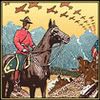 Somewhere in the archives, I have a very nice letter from Walt Disney regretfully declining the opportunity to work with me. Until the age of 12, I wanted to be a cartoonist, maybe have my own strip like “Dennis the Menace” and freelance. But I also wanted to work for Walt’s animation department. Even at that age, I instinctively knew I wasn’t whacked enough to belong in the Chuck Jones bullpen at Warner Brothers.
Somewhere in the archives, I have a very nice letter from Walt Disney regretfully declining the opportunity to work with me. Until the age of 12, I wanted to be a cartoonist, maybe have my own strip like “Dennis the Menace” and freelance. But I also wanted to work for Walt’s animation department. Even at that age, I instinctively knew I wasn’t whacked enough to belong in the Chuck Jones bullpen at Warner Brothers.I sent Walt a nice letter, a number of my best drawings and an estimate of what it would cost to move me and my family to Burbank. I was sure my dad could find a job once we got there, but I did feel obligated to cover some of the costs if we were going to uproot ourselves and become some theatrical Joad family lighting out for the promised land of California.
Walt wrote back, thanked me for the offer and praised my work, but insisted that I shouldn’t come knocking on his door until I’d gotten a high school diploma. To this day, I don’t know if he was thinking about my future or delivering my first letter of rejection. But by the time I finished high school it didn’t matter because Uncle Walt was in the freezer and my #2 pencils had been replaced by electric guitars and a bong.
But I read a lot of books about being a cartoonist and diligently watched “Learn to Draw” with John Gnagy. That was a half hour show where using the simple ability to draw a circle, a cube and a cone, John would turn out a masterpiece in under 20 minutes, spending the next ten shilling for his learn at home kits and giving out art tips.
I had great respect for anybody who could crank out a polished piece of work stopping only for a single commercial break. Although, looking back, I think John cheated a little. Virtually every one of his sketches ended up with a big honking tree in the foreground as “a natural frame” which also obliterated a third or more of the canvas.
The other day I realized that one of the things I’d learned during my cartoon training has stuck with me and continues to play a major role in my writing career. That’s something cartoonists call “The Morgue”.
A cartoonist’s morgue is a filing cabinet filled with doodles, drawings, tear sheets from magazines, photographs and other visual devices that become references or models when the time comes to draw something similar. In other words, you don’t have to have a model come in to pose with a pick-axe if you’ve got a chain gang photo to use instead.
Although having a naked lady hanging around the office is always a good thing – and it does allow the handcuffs to become a tax deduction.
But I digress….
When I wrote my first script, I started keeping a journal, writing down all the ideas I wasn’t using (but thought I might need later) and adding pictures and sketches as visual examples of what I was after. That has evolved over the years to making daily notations of story ideas, character traits, idiosyncrasies I’ve noticed about people with similar occupations or personalities.
I now have 40 or 50 black hardcover notebooks sitting within reach, each bursting with material I’ll probably never use and bent out of shape from all the clippings, photographs and drawings that have been glued into them.
Each time I write a script, I select one at random before I start my first revision and read through it, inevitably coming up with a legal pad page or two of one-liners, character shadings, jokes or visual ideas to incorporate into the pass.
I’ve always been careful to credit any quotes from outside sources, so those aren’t used, but often become a springboard to creating something new. And whenever one of my own entries is used, I cross it off so it doesn’t end up in something else.
Invariably, pulling material from the morgue helps me to focus on what I’m really trying to say with a script. And over time I’ve also noticed recurring themes and personal insights that end up giving the material an identity I can call my own.
No matter where you are in your writing career, it won’t hurt to take a few minutes a day to write down what you’ve been thinking about, reacting to or have heard in passing. It might not seem important now, but the day will come when it just might make something you’re writing better for its being in the morgue.




1 comment:
Nice one Jim...though the image of your 40-50 black hardcover notebooks filled with thoughts, notes, etc. brought to mind John Doe's (Kevin Spacey) notebooks in 'Se7en'...sick I know - maybe t'was the handcuffs that triggered it. Hmmm...I should write that down.
Post a Comment